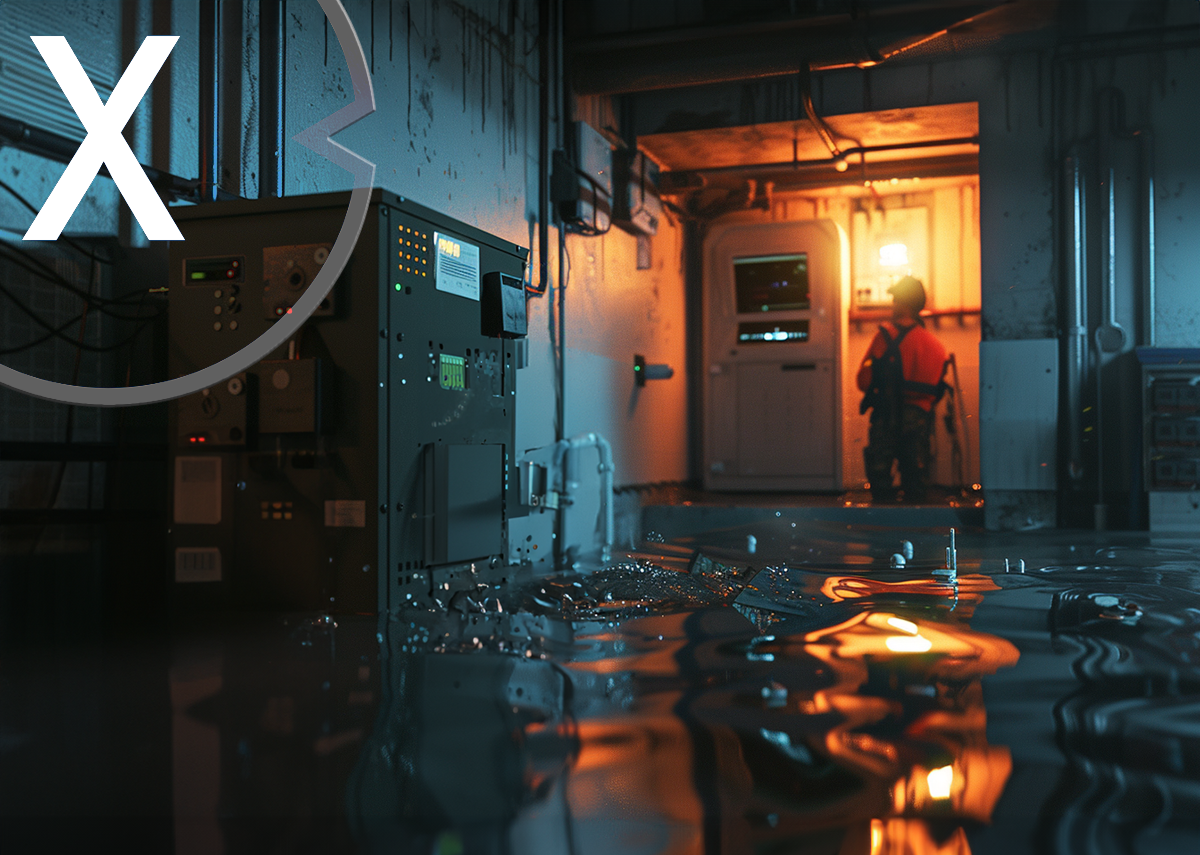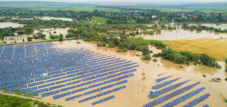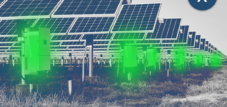Solar systems and floods: Risks, prevention and measures for inverters and electricity storage - advice and tips
Language selection 📢
Published on: September 16, 2024 / update from: September 16, 2024 - Author: Konrad Wolfenstein

Solar systems and floods: Risks, prevention and measures for inverters and electricity storage - advice and tips - Image: Xpert.Digital
🚿🌞 Flood-proof: Strategies to protect your solar system from water damage
🛡️☀️ Waterproof: The ultimate protection for solar systems against flooding
In times of increasing extreme weather events and the increasing popularity of photovoltaic systems, many homeowners are wondering how their solar system can be protected in the event of floods. Components installed in the basement, such as inverters and battery storage, are particularly at risk in such events. This article highlights the risks, preventive measures and necessary steps in an emergency.
💧 Risks for PV systems during floods
Photovoltaic systems consist of several components, some of which are particularly susceptible to water damage:
Solar panels
Roof-mounted solar panels are typically less at risk because they are out of reach of flooding. However, heavy rain and storms can cause damage.
Inverter
The inverter, which converts the direct current from the solar modules into grid-compliant alternating current, is often installed in the basement or ground floor and is therefore particularly at risk in the event of flooding.
Electricity storage
Similar to the inverter, power storage units are often located in lower areas of the house and are therefore exposed to increased risk.
cabling
The electrical wires that connect the various components can corrode or cause short circuits if they come into contact with water.
💡 Effects of water on electrical components
When water comes into contact with electrical devices such as inverters or battery storage, it can have serious consequences:
1. Short circuits
Water is a conductor and can bridge circuits, causing short circuits.
2. Corrosion
Even after drying, water residue can lead to corrosion on sensitive electronic components.
3. Insulation damage
The insulation of cables and components can be affected by contact with water.
4. Loss of power
Damaged components can lead to reduced performance or complete failure of the system.
5. Security risks
Water damage can compromise the system's safety mechanisms and lead to dangerous situations.
🛡️ Preventive measures
To minimize the risks to your PV system in the event of flooding, you should consider the following preventative measures:
Choice of location
When planning a new PV system, the location should be chosen carefully. If possible, install critical components such as inverters and battery storage on higher floors or water-safe areas.
Waterproof housing
Invest in waterproof enclosures for inverters and battery storage. These offer additional protection against moisture and water ingress.
Elevated installation
Mount the devices on the wall, at least one meter above the floor. This can provide sufficient protection in the event of minor flooding.
Regular maintenance
Have your system checked regularly by experts. Potential weak points can be identified and remedied at an early stage.
Drainage systems
Install effective drainage systems around your home to drain water quickly.
Backflow flaps
These prevent water from overloaded sewer systems from flowing back into your home.
Insurance coverage
Check your insurance policies and ensure that your PV system is adequately insured against flood damage.
🌩️ Measures in an emergency
If, despite all precautionary measures, a flood occurs that endangers your PV system, you need to act quickly and carefully:
1. Safety first
Do not enter flooded areas where electrical equipment is located. There is a danger to life from electric shock.
2. Switch off the system
Switch off the entire PV system using the main switch if it is safe to do so. Ideally, this should be done preventatively when there is a risk of flooding.
3. Contact a specialist
Immediately inform a qualified electrician or the installer of your PV system. Only specialists should check the system and put it back into operation after a flood.
4. Documentation
Photograph any damage for insurance purposes before beginning any cleanup.
5. Drying
After the water has drained away, all affected components must be thoroughly dried. Use professional drying equipment for this.
6. Inspection and repair
Have all components of the system inspected by a specialist. Damaged parts must be repaired or replaced.
7. Recommissioning
Only put the system back into operation once a specialist has confirmed its safety and functionality.
🌱 Long-term consequences and rehabilitation
Even if a PV system has been dried and repaired after a flood, long-term consequences can occur:
corrosion
Even after careful drying, residual moisture can lead to gradual corrosion. This can shorten the life of the components.
Decreased performance
Water damage can cause inverters and battery storage to lose efficiency, resulting in reduced overall performance of the system.
Increased probability of failure
Components that were once flooded often have a higher chance of failing in the future.
Loss of warranty
Water damage can void manufacturer warranties. Check the warranty conditions of your system components.
To minimize these long-term consequences, consider the following steps:
1. Thorough inspection
Have the system checked by experts at regular intervals after the flood event.
2. Preventive exchange
Consider preemptively replacing critical components, even if they still appear functional after the flood.
3. Modernization
Take advantage of the opportunity to modernize your system and bring it up to date with the latest technology. This can increase efficiency and reliability.
4. Location optimization
Reconsider the positioning of vulnerable components and, if necessary, move them to safer locations in the home.
⚖️ Legal and insurance aspects
Legal and insurance issues also play an important role in flood damage to PV systems:
Insurance coverage
Check whether your existing insurance (building insurance, special PV system insurance) covers flood damage. Many standard policies exclude natural damage.
Natural hazard insurance
Additional natural hazard insurance can be useful to cover damage caused by natural events such as floods.
Documentation requirement
Keep a logbook of maintenance, repairs and any damage to your PV system. This can be important for settlement by the insurance company in the event of damage.
Liability issues
Clarify who is liable in the event of damage - especially if the system was planned and installed by a service provider.
🔄 Technological developments and future prospects
The solar industry is continuously working on solutions to make PV systems more resistant to environmental influences:
Waterproof components
Manufacturers are increasingly developing inverters and battery storage systems with increased protection against water and moisture.
Intelligent surveillance systems
Modern PV systems can be equipped with sensors that provide early warning of water ingress and automatically initiate protective measures.
Modular systems
New approaches to system design enable more flexible placement of components, which makes it easier to adapt to individual circumstances.
📝 Recommendations for action
Flooding and flooding pose a serious threat to photovoltaic systems, especially components installed in the basement or ground floor, such as inverters and battery storage. However, the risk of damage can be significantly reduced through forward-looking planning, regular maintenance and appropriate protective measures.
It is recommended for owners of PV systems:
- Check the positioning of critical components and adjust if necessary.
- Investing in high-quality, waterproof housings and protection devices.
- Create an emergency plan in the event of an impending flood.
- Have regular maintenance and inspections carried out by professionals.
- Check the insurance coverage and adjust it if necessary.
- Keep up to date with technological developments and improvement opportunities for your own system.
With the increasing importance of renewable energies and the simultaneous increase in extreme weather events, protecting PV systems from flooding will become even more important in the future. However, by acting prudently and using modern technologies, plant owners can ensure that their clean energy investment remains protected and profitable in the long term.
📣 Similar topics
- 🌊 Avert disaster: How to protect solar systems from flooding
- 🚧 Safety measures for PV systems during floods
- 💧 Avoid water damage: Protection for your solar PV system
- 🏠 Flood safety for solar home installations
- 🔋 Particularly vulnerable components: Protection of battery storage and inverters
- ⚡ Short circuits and corrosion: risks for solar systems
- 🚨 What to do in an emergency? Act quickly if there is a risk of flooding
- 🛠 Preventive measures for solar systems: Effective solutions
- 📸 Documentation and insurance: What you should know
- 🌍 Modern technologies: Future trends in the protection of solar systems
#️⃣ Hashtags: #Security #Flood Protection #Photovoltaic Systems #RenewableEnergy #Prevention
🌊☀️ PV system: Floods and floods: What happens to the inverter and battery storage when the basement fills up? What to do?

PV system underwater: What happens to the inverter and battery storage if the basement fills up? – Image: Xpert.Digital
Photovoltaic (PV) systems are one of the most popular ways to generate clean and renewable energy. These systems consist of several essential components, such as solar panels, inverters and, in many cases, battery storage, all of which work together to convert solar energy into usable electricity for homes and businesses. But how does a PV system behave during extreme weather events such as floods or floods? And what protective measures are necessary to prevent expensive damage?
One of the biggest challenges that PV system owners face during floods is the potential for water to enter the basement or other areas of the home where the inverter and battery storage are installed. These devices are essential for the functionality of the entire PV system, but they are also sensitive to water damage. A full cellar can have serious consequences for the safety and functionality of the PV system. But what impact do these situations have on technical equipment and how can you protect yourself?
More about it here:
We are there for you - advice - planning - implementation - project management
☑️ Industry expert, here with his own Xpert.Digital industry hub with over 2,500 specialist articles
I would be happy to serve as your personal advisor.
You can contact me by filling out the contact form below or simply call me on +49 89 89 674 804 (Munich) .
I'm looking forward to our joint project.
Xpert.Digital - Konrad Wolfenstein
Xpert.Digital is a hub for industry with a focus on digitalization, mechanical engineering, logistics/intralogistics and photovoltaics.
With our 360° business development solution, we support well-known companies from new business to after sales.
Market intelligence, smarketing, marketing automation, content development, PR, mail campaigns, personalized social media and lead nurturing are part of our digital tools.
You can find out more at: www.xpert.digital - www.xpert.solar - www.xpert.plus



























